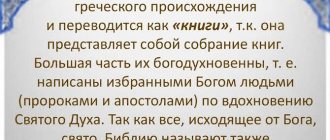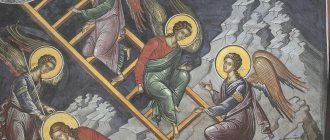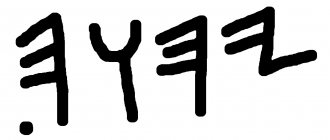Why should a modern Christian read the Old Testament?
According to the thought of the holy fathers, in particular, Blessed Aurelius Augustine, “The New Testament is hidden in the Old, the Old Testament is revealed in the New.” The Old Testament is not a collection of ancient myths, tales and legends, as some believe. Reading the Old Testament through the prism of the New, a person, no matter what era he lived in, can see that the Old Testament prepared humanity for the acceptance of the Son of God, that this was its main task. Talking with teachers of the law, Jesus Christ said: “Search the Scriptures, for through them you think you have eternal life; and they testify of Me” (John 5:39). That is, the Old Testament tells us about Jesus Christ, and that is why we, Christians, should read it even thousands of years after it was written. The Old Testament leads us to Christ and allows us to better understand the New.
In addition, the Old Testament is part of the Holy Scriptures (and in terms of its volume it significantly exceeds the New Testament), which means that it was written by God's inspiration, through the Holy Spirit working in chosen men. All Holy Scripture - be it the Old Testament or the New - is spiritual food that has a beneficial effect on our soul, saturating it with the Word of God. Therefore, reading the Old Testament is both useful and edifying.
The essence of the Bible, its composition and structure
The Bible is a Hermetic philosophical work that synthesizes science, religion and the art of human spiritual and metaphorical thinking. Allegories, metaphors and comparisons transform the verbal (symbolic) presentation of information into an eidos way of storing and transmitting knowledge (a type of memory based on visual representations). In this case, metaphysics is used for a simplified presentation of knowledge, and mysticism is just a way of transmitting knowledge using figurative holograms of the subconscious. A person perceives up to 80% of information visually, and everything spiritual and ingenious is connected with our subconscious. But the eidos method of transmitting information is a potentially unstable system, therefore, in order to preserve spiritual knowledge, people developed left-hemisphere and right-hemisphere thinking. Men's thinking is mainly left-hemisphere rational, moving progress and consciousness. Women's thinking is by its nature right-hemisphere, intuitive, humanitarian and more universal. When parables, allegories and metaphors (female thinking) are synthesized around rational knowledge (male thinking), then when searching for semantic connections, thinking is formed with a displaced point of information assembly, which forms syncretic perception capable of connecting disparate elements into one system. This method of transmitting thinking is not considered to be any kind of teaching, but it is widely used in literature, theater, art, cinema and works of art. In this case, the function of symbols and the eidos method of transmitting information is reduced to influencing the neural structure of a person, transforming it and opening access to those layers of consciousness that, as a rule, are closed to ordinary perception. Figuratively speaking, this is a kind of circumcision of a person’s heart or mind (Deut. 30:6). Comparing this grandiose ideal of esoteric Christianity with the teachings of the church, it becomes clear that Christianity has lost the keys to the esoteric understanding of Scripture and its secret deep meaning and purpose. Jesus Christ said: “For as lightning comes from the East and is visible to the west, so will be the coming of the Son of Man... coming on the clouds” (Matthew 24: 27-30). In Scripture, clouds are an allegory of the mysteries of the Spirit, and lightning is a symbol of illumination. The male image in mystical teachings always denotes a rationally knowable secret. Therefore, the discovery of the metaphorical secrets of Scripture requires a synthesis of rational and irrational thinking, which leads to the discovery of a new layer of information and spiritual insight. The Bible is a test for spiritual consciousness and thinking. I can send it, give me your email.
Why do many of the Old Testament requirements seem so harsh?
Evaluating some Old Testament (legalized) norms of behavior, as well as some actions of people of the pre-Christian era, committed at the special request of God, many contemporaries regard them as unjustifiably cruel. This often causes reproaches against Christians from heterodox or atheists, saying, look what a cruel “god” you believe in. In reality, God is not the author of unjustified, excessive cruelty. He is a Lover of Humanity. When making such assessments of the Old Testament, its accusers, as a rule, do not adequately take into account the historical context within which the events took place and the moral state of the people of the pre-Christian era. Note that if in those days bloody scenes were perceived by many as the norm, and now their description shocks readers of the Bible, then this can be considered as evidence of the truth of Christian teaching, the effectiveness of Christianity, under the influence of which the moral consciousness of the masses has changed for the better.
How to read the Old Testament correctly?
There is an opinion that it is better to start studying the Holy Scriptures with the New Testament, and it should be studied based on Orthodox interpretations. And only after familiarizing yourself with the books of the New Testament is it appropriate to begin studying the Old Testament Scripture. This approach will help the novice reader of the Bible avoid many temptations, bewilderments, questions from the series: “Where is love for one’s neighbor?”, “Where was God looking?”... Of course, this recommendation cannot be considered unconditional, but, nevertheless, in a number of cases it really applies.
In addition, those starting to study the Old Testament can be recommended to read it not immediately from cover to cover, but in blocks: start with one book, while simultaneously studying the commentaries, information about at what time, by whom and for whom it was written. It's important to immerse yourself in context. Then you can start reading and understanding the second, third, etc. You can also read chapter by chapter.
For a systematic, deeper study of the Holy Scriptures, you can use additional literature of an exegetical, textual, historical, dogmatic nature, etc. These works are widely presented on the website “ABC of Faith” in the “Biblical Studies” section. The “Explanatory Bible” by A.P. can be a great help to the student of Scripture. Lopukhina. Let's not forget about the works of the holy fathers. All this will help you become more familiar with the texts of the Old Testament and avoid literalism and formalism.
Registration
- a state system of control over population migration that developed in the USSR and exists in a number of states located on its former territory, including Russia, the principle of which is to strictly bind citizens to their permanent place of residence.
In states with a current registration system, every citizen is required to undergo the registration procedure at his place of residence. As a rule, registration is accompanied by a mark in the passport or other identity document.
The main difference between propiska and residence registration systems that exist in some democratic countries is its permissive nature. Since the mechanism for exercising civil rights and obligations in states with a current registration system is usually in one way or another connected with the place of residence confirmed by registration, the permissive nature of registration leads to restrictions on freedom of movement and other rights and freedoms of a citizen, and also paradoxically prevents him from fulfilling his duties to the state .
Temporary registration
- according to the decree of the Government of the Russian Federation “On amendments to the Rules for registration and deregistration of citizens of the Russian Federation at the place of stay and at the place of residence within the Russian Federation” dated 2004, Russian citizens are required to temporarily register at the place of residence when staying in a given residential premises more than 90 days.
According to the updated Code of Administrative Offenses (CAO), from November 28, the fine for violations of the passport and visa regime for Russians is 2,500 rubles. For foreigners, “failure to comply with the registration regime” - 1,500 rubles. Since January 1, 2007, registration of foreigners temporarily staying in the Russian Federation has been abolished, and notification migration registration has been introduced instead.
Why register?
Currently, the procedure for registration at the place of residence and stay is determined by the 1993 law “On the right of citizens of the Russian Federation to freedom of movement, choice of place of stay and residence within the Russian Federation” and “Rules for registration and deregistration of citizens of the Russian Federation at the place of residence and at the place of residence within the Russian Federation" dated July 17, 1995.
In the constituent entities of the Russian Federation, where local authorities pay special attention to compliance with the registration regime, arbitrary checks of documents by police officers of citizens, including on the streets, have become widespread, the main purpose of which is to identify persons who do not have registration in the relevant locality. Such citizens are fined or, as is confirmed by numerous evidence, subjected to extortion of bribes. The authorities' fight against this phenomenon is limited mainly to declarations. However, since December 2003, amendments to the Code of Laws on Administrative Offenses abolished liability for staying on the territory of Russia without registration, leaving liability only for residence (the burden of proof of which, by law, falls on the police officers themselves), which put a formal end to checks of citizens on the streets . Only citizens’ ignorance of the laws allows the police to continue to commit arbitrariness.
A serious liberalization of the registration regime for Russian citizens was made by the Decree of the Government of the Russian Federation of December 22, 2004, which changed the period after which registration is required from 3 days to 90. Thus, Russian citizens got the opportunity to live in any locality without registration, if once in quarter to travel for at least an hour to another locality and keep the ticket as confirmation of such a trip.
It should be noted that the problems of a migrant are not limited to contacts with police representatives both on the street and when re-issuing documents - internal and international passports, driver’s licenses, etc. Without registration
in practice
, it is not possible to obtain a compulsory medical insurance policy
at the place of work (compulsory health insurance); it is much
more difficult to rent a car
and
gain access to more attractive bank lending programs.
Visitors who live in rented apartments for six months, 3 years, 5 years - if they do not register, they are subject to a fine
up to 2500 rubles.
Also, according to the law
of an apartment who provides his living space for residence to persons without registration is fined The fine is also up to 2,500 rubles.
How to apply?
Citizens who arrived for temporary residence in residential premises that are not their place of residence for a period of more than 90 days are required, after the expiration of the specified period, to contact the officials responsible for registration and submit:
- identification document;
- application in the established form for registration at the place of residence;
- a document that is the basis for the temporary residence of a citizen in the specified residential premises (tenancy (sublease) agreements, social tenancy of residential premises or an application from the person providing the citizen with residential premises).
In the absence of housing maintenance organizations when occupying residential premises owned by citizens or legal entities, the specified documents are presented to these citizens or a representative of the legal entity who is entrusted with the responsibility for monitoring the use of residential premises.
Registration of citizens at the place of stay in residential premises that are not their place of residence is carried out for a period determined by mutual agreement:
with tenants and all adult citizens living together with them, subject to living in state or municipal housing stock;
with owners of residential premises;
with the boards of housing construction or housing cooperatives, if the members of the cooperatives are not the owners of these residential premises.
Officials responsible for registration, as well as citizens and legal entities providing residential premises owned by them for residence, within 3 days from the date of citizens’ application, transfer the documents specified in paragraph 9 of these Rules to the registration authorities.
Registration authorities, within 3 days from the date of receipt of documents, register citizens in the prescribed manner at the place of stay in residential premises that are not their place of residence, and issue them a certificate of registration at the place of stay.
Registration of a foreign guest takes 1-1.5 days. It all depends on the timely submission of documents. Required: copy of passport, copy of current visa, copy of migration card.
To obtain registration of a foreign guest you need
:
1.
Collect the following documents: · passport or other identification document (with unexpired validity); · migration card, which contains a mark from border guards about entry into Russian territory; · issued multiple-entry Russian visa with a validity period of at least 1 year; · a document on the basis of which check-in into this residential premises takes place (an order, if living in a dormitory, a lease agreement or an application from the owner, if in an apartment or residential building), or a certified copy thereof; · health insurance policy valid in Russia; · a certificate of testing to verify that you are HIV-infected, which must be completed at a Russian medical organization; · 4 photographs for documents measuring 35x45 mm.
2.
Obtain from the international department of the university, the dormitory or the passport and visa department of the internal affairs body of the region where the university is located and fill out an application form for registration at the place of residence or permanent residence in 2 copies. It must be filled out legibly by hand or printed on a computer in Russian. Abbreviations must not be used when filling out. Answers to the application questions must be comprehensive.
3.
Pay the state fee for registration at the place of residence or stay (its amount is currently 1 ruble for every day of stay in Russia, but in total no more than 200 rubles, that is, you will have to pay 200 rubles for registration for a year). You can pay it at any bank branch, where, at your request, they will show you a sample of filling out a receipt for payment of the state duty.
4.
Submit your application to the passport and visa department of the internal affairs body (in person or through employees of the international department of the university) with all the documents you have collected (see paragraph 1) and a receipt for payment of the fee.
5.
Receive a registration stamp or written notification of the reasons for refusal of registration within 3 days from the date of submission of documents. They will also return all documents you submitted, except for the application. If, when checking your documents, it turns out that you do not have current registration at your place of residence or stay for 1 or more days, you will be considered to have violated the regime of stay in the Russian Federation, an administrative violation protocol will be drawn up in this regard, and you may be required to pay a fine (from 1000 to 1500 rubles). If you violate the passport regime twice, the court may decide to administratively expel you from Russia, after which you will not be able to re-enter for 5 years.
Additionally:
consultant.ru - Consultant Plus. List of officials responsible for registration. Rules for registration and deregistration.
hrworld.ru - Rights of foreign students. How to register?
irn.ru - We register. The questions are answered by the head of the Department of Passport Work and Population Registration of the Federal Migration Service of Russia.
Who is the author of the Old Testament?
The Old Testament, as part of the Bible, is the work of God and man. On the one hand, it is argued that the Old Testament was written by a whole team of authors, outstanding representatives of the Jewish people who lived in different historical periods. Their works differ from each other not only in content: for example, each of them has its own literary style. What unites them is their main theme: they all tell us about God and how He acts in this world. However, the main thing that gives the biblical books unity is that all the authors of the biblical books drew their inspiration from a common source. This source was the Spirit of God. The task of the people, as co-authors, was to express and present what was revealed to them by the inspiration of God in proper literary form.
On what basis do we call the Testament “Old”?
The expression "Old Testament" has its basis in Holy Scripture. It is found in the Epistle of the Apostle Paul to the Corinthians (2 Cor. 3:14), where it is associated with the Mosaic Law. In the allegorical comparison of Sarah and Hagar (Gal. 4:22-26), the Apostle Paul contrasts the Sinai Covenant with the New Covenant, which implies man's free and conscious desire for unity with God.
Regarding early Christian literature, it can be noted that, for example, in the 2nd century. the concept of “Old Testament” (ancient Greek Παλαιὰ Διαθήκη), in contrast to the New Testament (Καινή Διαθήκη), was used by Melito of Sardia and Origen (See on this subject: “Eclogues”).
As for the expression “New Covenant,” the basis for its use is, in particular, the prophecy of Jeremiah about the conclusion of the New Covenant: “Behold, the days are coming, says the Lord, when I will make a new covenant with the house of Israel and with the house of Judah, not like this covenant, which I made with their fathers in the day when I took them by the hand to bring them out of the land of Egypt; They broke that covenant of mine, although I remained in covenant with them, says the Lord” (Jer. 31:31-32).
The meaning of the covenant in different religions
In every religion this concept has its own meaning.
In Christianity
In Christianity it has the following meanings:
- Christian scripture that arose after the birth of Jesus Christ.
- A term that denotes a new qualitative relationship between God and man.
- The main commandments of Christianity.
In Judaism
In Judaism, the concept has a large number of meanings:
- One of the schools of Calvinist thought that views all history as a series of covenants between God and people.
- The Seven Commandments, which according to Judaism are necessary for humanity.
- 10 commandments of Moses.
- Circumcision is a surgical operation that removes the foreskin from boys and men, as a sacrificial offering of a part of one’s body to the Lord.
In other religions
In other religions it has several meanings:
- In the Baha'i religion, an agreement that is concluded by a believer at the moment he accepts a particular religion.
- Concepts of many authors who strive to create a modern new worldview.
- The Abrahamic contract in Mormonism is the contract of exaltation that was made between God and Abraham at the time of Abraham's celestial marriage.
Celestial marriage is a major part of preparation for eternal life. It requires entering into a marriage partnership with the right person in the right place, and faithfully keeping that sacred covenant.
There is no concept of covenant in Islam. The Koran does not say anything about the agreement that Allah would enter into with Muslims. Allah sends down to the prophets and messengers each his own text. The messenger's task is to convey a text, which, in essence, is instructions for correct behavior. This is a mandate, or even an order. Muslims did not accept either Christian or Jewish scriptures.
Is the Old Testament used in church worship?
The Old Testament is widely used in Orthodox worship. For example, psalms are used as a constant basis for daily services: “evening psalm” (Ps. 103) after vespers; six psalms (Ps. 3, 37, 62, 87, 102, 142) and psalms of praise (Ps. 148, 149, 150) during Matins; three psalms at each hour; The Liturgy ends with a “thanksgiving psalm” (Ps. 33), and at the beginning of the Liturgy of the word we hear “Imaginative” antiphons (Ps. 102, 145) and so on. In addition, the entire Psalter is divided into twenty parts - kathisma, which are read weekly during Vespers and Matins. During Lent, the entire Psalter is read twice every week. Again, during Lent, reading other Old Testament Books is practiced. Another component of Orthodox worship associated with the use of the Scriptures of the Old Testament is the reading of proverbs - fragments of the Bible intended for reading on special occasions. Proverbs are read on the eve of a number of major (or temple) holidays, during the days of Great Lent, and also during the performance of certain services. Let's not forget about the Great Canon of Penitence, the author of which, St. Andrei Kritsky, to review the listed sins, examines Biblical history, while in the first eight songs of the canon he turns mainly to the Old Testament.
COVENANT
The meaning of the word "testament" in Russian. translation of the OT is connected with the Greek. the term διαθήκη - agreement, testament, which in the translation of the Septuagint became the main equivalent of Hebrew. words - contract, agreement. Dr. the terms for "contract" in the OT ( ) are also usually translated by διαθήκη. The shift in the meaning of the word “agreement” to the meaning of the word “covenant” became possible due to the polysemy of the Greek. words, but the decisive factor in this process was the interpretation of the text of the Old Testament in early Christ. exegesis.
A convincing etymology of Hebrew has not yet been found. words . Several things have been considered in science. assumptions.
1. It is derived from Hebrew. verb root I - is and originally meant “meal”; This assumption is based on the fact that the conclusion of the agreement in Dr. Israel, as in other countries of the ancient Nearby. East, in some cases it was accompanied by a joint meal of the contracting parties (cf.: Gen. 26. 28-30; 31. 44-54), cf. Greek σπονδή - libation, agreement.
2. This word is a derivative of the verbal root II - to look, not recorded in Hebrew, but found in Akkad. ( ) and in Arabic. (Heb. - to consider) languages; the assumption is based on a comparison with the word - agreement (Isa. 28. 15, 18), derived from Hebrew. verb root - look.
3. - borrowing from Akkadian, cf.: Akkad. - between; it is assumed that the original Akkad. word in Hebrew language has undergone semantic transformations: initially used as a preposition, it began to function as an adverb, and then as a noun; this etymology is based on the observation that the conclusion of a contract may involve dissecting the bodies of sacrificial animals and placing the contracting parties "between" the dissected halves. In connection with this etymology, Akkadian is of interest. the expression JXY, meaning “to slaughter a colt [as a sign of a peace treaty] between X and Y,” cf.: J - “to slaughter a colt of peace” (i.e., a peace treaty). Akkad. which is a variant of word I (division, dividing wall, boundary), apparently, can also be considered within the framework of this hypothesis; This assumption is supported by the fact that sometimes the conclusion of an agreement was associated with the division of territory and the establishment of boundaries (Jacob and Laban, Gen. 31.44-54).
4. Heb. is a borrowing with semantic transformation from Akkadian, cf.: Akkad. II ( ) - clasp, shackles; A similar semantic development is observed in Akkadian. - ligament, belt, connection, as well as contract, agreement; in Arabic - connection, binding, contract, cf. also lat. vinculum fidei. As M. Weinfeld points out, Greek terms associated with the meaning of “contract” originally also denoted a connection: συνθήκη - combination, binding; agreement, contract, ἀρμονία - bonding, connection, bond, agreement, agreement (Weinfeld. 1975).
In connection with the origin of the word, the texts of ser. 2nd millennium BC from Qatna (Syria), in which the expression TAR be-ri-ti is found. Since the range of meanings of the Sumerogram TAR is associated with the idea of cutting, dissecting (Akkad.), W. Albright suggested comparing this expression with the Hebrew. - conclude an agreement (lit. - cut an agreement). However, it is possible that in the texts from Qatna the word is a borrowing from some West Semitic language. a language close to Hebrew (this opinion is expressed, in particular, in: A Concise Dictionary of Akkadian. 2000).
Assumption 4 has received the greatest recognition; following Weinfeld, one of the most authoritative researchers of the Old Testament tradition associated with the concept of “contract,” it is supported by many. scientists.
The use of the word and conceptually related words in the OT ( ) can be divided into 3 main groups: designation of various contracts and agreements between people and groups of people; designation of God's covenant with the people of Israel; metaphorical use. The greatest semantic diversity of the concept is noted in the 1st group. The texts of the OT show that the various treaties and agreements that were a daily reality in Dr. Israel, as in other countries of the ancient Nearby. East, were designated by the word or expression. Exactly the same terminology is used in relation to contracts between God and people. In the 1st group, it is customary to distinguish 2 types of contracts: contracts between equals and contracts between persons at different levels of the social hierarchy.
Agreements between equals primarily include international agreements, for example. between Solomon and Hiram, king of Tire (3 Kings 5.12), between the king of Judah Asa and Aram. king Benhadad (3 Kings 15.19), between the king of Israel Ahab and Benhadad (3 Kings 20.34). This subgroup includes treaties between tribes and confederations of tribes: between Israel and the Canaanites (a warning against concluding treaties with them in Exodus 23:32), between Israel and the inhabitants of Gibeon (Joshua 9:18). The agreements between Abraham and Abimelech (Genesis 21:22-34), Isaac and Abimelech (Genesis 26:12-31), Jacob and Laban (Genesis 31:43-54) are essentially agreements between groups of people (clans or family communities) . Perhaps the only agreement between two private individuals mentioned in the OT is the agreement between David and Jonathan (1 Sam. 18.3). In a number of cases, it is more or less obvious that the contracting parties are not entirely equal; often one of the parties takes a stronger position (Ahab in relation to Ben-hadad, Israel in relation to the inhabitants of Gibeon, etc.); in such cases, the initiator of the contract is usually the weaker party. The nature of these agreements is not always clear, but, as a rule, they imply peaceful obligations, in particular not to violate borders, legitimize the right to own a certain territory, guarantee mutual economic assistance, or ensure the right to trade in a certain area. The listed terms of agreements show that behind the terminological uniformity (all of them are designated by the term or expression) there is a fairly large variety of legal transactions. Judging by Mal 2.14, the marriage contract could also be called.
A special area of use of the term is in texts that deal with the agreement between God and people. This is, in particular, Z. with Noah (Gen. 9. 8-17; Isa. 54. 17), with Abraham (Gen. 15. 18; 17. 1-16), with the people of Israel on Mount Sinai (Ex. 19. 5; 24.3-8; 34.10; Deut. 4.13; Isaiah 56.4, etc.). Adjacent to this group of texts are references to Z., in which God appears on one side, and on the other, the leaders and kings of Israel along with the people of Israel (Joiada, 2 Kings 11.17; Hezekiah, 2 Chron. 29.10; Josiah, 2 Kings 23.3), as well as the agreement of God with Ezra and the people of Israel (1 Ezra 10.3). In the mentioned texts, the main condition of Z. is the obligation of the king and the people to observe the law of the Lord and be faithful only to Him. Z. God and David cannot be placed in this row, since here the Lord’s promise to preserve the dynasty of David on the throne comes to the fore (Ps 88.4-5; 131.11). A separate group consists of prophetic texts, which, in addition to Z., speak of the so-called. a new covenant ( ) with the people of Israel on completely new terms. Among the texts of the prophets (Isa 42.6; 49.8; 55.3; Jer 32.40; 50.5; Eze 16.60; 20.37), in which the word “Z” is used, Jer 31 stands out 31-40 as a foundational text; the minor prophets have the only mention of Z. in Hosea 2. 18-23.
To determine the range of euro values.
it is necessary to take into account comparisons of ancient Hebrew. treaties with the ancient East, and especially with Mesopotamian treaties. Weinfeld put forward the assumption that typologically the Sinai covenant of God with Israel corresponds to an obligatory covenant or a treaty itself, and the agreement of God with Abraham and David corresponds to a promissory covenant or a deed of gift (grant). In the 1st case we are talking about the obligations of the vassal in relation to the master (treaty and the Treaty of Sinai), in the 2nd case - about the obligations of the master in relation to his subjects or vassals (the treaties with Abraham and David). Weinfeld's theory was very influential in the 70s and 80s. XX century, in the 90s. Works appeared that questioned the legitimacy of such analogies (Gary Knoppers and others). A. K. Lyavdansky
For ease of study, is it possible to divide the Old Testament into some kind of blocks according to content?
According to the method of writing, the books of the Old Testament are divided into canonical and non-canonical. The former are recognized by the Church as divinely inspired, while the latter are not recognized. Meanwhile, non-canonical books are considered edifying and useful.
According to the content, the books of the Old Testament can be divided into:
- books of law: the Pentateuch (Genesis, Exodus, Leviticus, Numbers, Deuteronomy);
- historical: the books of Joshua, Judges, Ruth, four books of Kings, two Chronicles, Books of Ezra, Nehemiah, Tobit, Judith, Esther, three Maccabees books;
- teaching (poetic): books of Job, Psalms, Proverbs of Solomon, Ecclesiastes, Song of Songs, Wisdom of Solomon, Wisdom of Jesus, son of Sirach;
- prophetic: the books of the prophets Isaiah, Jeremiah, Lamentations of Jeremiah, the Epistle of Jeremiah, the prophets Baruch, Ezekiel, Daniel and the books of the “minor prophets”: Hosea, Joel, Amos, Obadiah, Jonah, Micah, Nahum, Habakkuk, Zephaniah, Haggai, Zechariah, Malachi .
Biography - Old Testament, philosophy Old Books Old Works Old
Biography
The old testament is the first, oldest of the two (along with the New Testament) part of the Christian Bible, the ancient Jewish Holy Scripture (Tanakh), the common sacred text of Judaism and Christianity. The books of the Old Testament were written between the 13th and 1st centuries. BC e. in Hebrew, with the exception of some parts of the books of Daniel and Ezra, which are written in Aramaic. In the period from the 3rd century BC. e. to 1st century AD e. The Old Testament was translated into ancient Greek. This translation (Septuagint) was used by early Christians and played an important role in the establishment of the Christian canon of the Old Testament.
Origin of the term. The term “Old Testament” is a translation from ancient Greek. Παλαιὰ Διαθήκη in Old Church Slavonic (Old Slavic vetykh - “old”, “ancient”). The ancient Greek word παλαιὰ literally means “the former”, and διαθήκη means “will”, “agreement”, “contract” or “covenant”. With this word, the creators of the Septuagint conveyed the Hebrew ברית (Brit, “treaty, agreement”). In the biblical world, “covenant” (Heb. ברית Brit) was a widespread type of relationship, and was expressed in a solemn agreement between the parties, accompanied by the uttering of oaths. a covenant made between people often meant a mutual agreement for cooperation or peace. Such a covenant could be an agreement between private individuals (Gen. 31:44, 1 Sam. 18:3), an agreement between a king and a private individual (Gen. 21:27, 2 Sam. 3:12), or an agreement between kings or states (2 Sam. 5:1-3, 1 Kings 15:19). another type of covenant meant a solemn promise of a one-sided nature, a kind of “oath” in which one of the parties agreed to perform certain actions (2 Kings 23:3). A special type was the covenant concluded between God and man. Such a covenant is similar to the agreement of a ruler granting rights to his subjects, widespread in the Middle East (Gen. 9:1-17). For the first time, the term “Old Testament” (ancient Greek Παλαιὰ Διαθήκη) appears in 2 Cor. 3:14, where it is associated with the Mosaic Law recorded in the Pentateuch, and perhaps the author traditionally understands it as obligations imposed by God on the people (cf. Heb. 9:1). In the allegory of Sarah and Hagar (Gal. 4:25), the Apostle Paul contrasts the Sinai covenant with a new covenant for Israel, which is no longer an imposed obligation, but is based on a living relationship between God and man. In relation to the books of the Jewish Holy Scripture and Christian works, the terms “Old Testament” (Παλαιὰ Διαθήκη) and “New Testament” (Καινή Διαθήκη) first appeared in the 2nd century. n. e. in the works of early Christian writers (Meliton of Sardis, Origen). “Meliton greetings brother Onesimus. Out of zeal for our faith, you have often asked me to make you selections from the Law and the Prophets relating to the Savior and to our entire faith; you wanted to know exactly the number of Old Testament books and the order in which they are located. I tried to fulfill your desire, knowing your zeal for the faith and curiosity for its teaching; you consider this the most important thing, loving God and working for eternal salvation. I went east and went to the places where the Scriptures were preached and fulfilled, I found out exactly about the Old Testament books and sent you a list of them. Here are their names: the five books of Moses - Genesis, Exodus, Leviticus, Numbers, Deuteronomy; Joshua, Judges, Ruth, four books of Kings; two Chronicles, Psalms of David, Proverbs of Solomon, or the book of Wisdom, Ecclesiastes, Song of Songs, Job; prophets: Isaiah, Jeremiah and the twelve in one book, Daniel, Ezekiel, Ezra. From these I made selections, dividing them into six books.” According to Christian tradition, the division of Holy Scripture into the New and Old Testaments is based on verses from the Book of the Prophet Jeremiah (Jer. 31:31). “Behold, the days are coming, says the Lord, when I will make a new covenant with the house of Israel and with the house of Judah.”
Contents of the Old Testament (Tanakh). Pentateuch (Torah) From the creation of the world and man to the arrival of the Jews in Moab. This book describes: the Fall, the expulsion of Adam and Eve from paradise, the flood and Noah's Ark, the lives of Abraham, Isaac and Jacob. Joseph in Egypt. The division of Israel into tribes. Prophets (Nevi'im). From the conquest of Canaan to the division of Israel into two kingdoms. Events: resettlement of the tribes of Israel, foundation of the kingdom, reign of David and Solomon. Founding of Jerusalem and construction of the First Temple. The division of Israel into two kingdoms.
Scriptures (Ketuvim). From the division of the kingdoms to the restoration of the Second Temple. Babylonian captivity, destruction of the First Temple. In 515 BC. – construction of the Second Temple by Zerubbabel after the fall of Babylon. Events of the book of Esther during the reign of Artaxerxes (465-424 BC). Prophets Daniel, Ezra, Nehemiah.
authorship. The books of the Old Testament were written by several dozen authors over many centuries. Most books had, according to tradition, their own authors, who were indicated in the title of the book. Some modern scholars are of the opinion that most of the books of the Old Testament were written by anonymous authors.
Text sources. The text of the Old Testament has come down to us in many ancient and medieval manuscripts used in modern editions. These include texts in Hebrew and ancient translations, among which the most important are the Septuagint, a translation into ancient Greek made in Alexandria in the 3rd-1st centuries BC. e., Vulgate - translation into Latin made by Jerome of Stridon at the end of the 4th - beginning of the 5th century AD, Targums - translations into Aramaic and Peshitta - translation into Syriac made among early Christians in the 2nd century AD. e. Among the manuscripts in Hebrew, an important place is occupied by the medieval manuscripts of the Masoretic text - the official text of Judaism, among which the Leningrad and Aleppo codes are considered the most authoritative. The most ancient sources of the text of the Old Testament are the Qumran manuscripts, which contain fragments of all the books of the Old Testament, with the exception of the books of Esther and Nehemiah, as well as the complete text of the book of the prophet Isaiah.
An important place among the sources of the Old Testament is occupied by the Samaritan Pentateuch - the Hebrew text of the Pentateuch, written down in one of the varieties of Paleo-Hebrew writing (Samaritan letter) and preserved by the Samaritan community.
Church Slavonic translations of the Old Testament - the Gennadian Bible, the Ostroh Bible and the Elizabethan Bible were made from the Septuagint. Modern Russian translations - the Synodal translation and the translation of the Russian Bible Society - are made on the basis of the Masoretic text.
Canon of the Old Testament. The Jewish and Alexandrian Canons The Canon of the Old Testament is a set of Old Testament books recognized by the Church as divinely inspired. The enumeration of the canonical Old Testament books is already found in the doxography of Origen. The divine inspiration of the books of the Old Testament canon, as well as its continuity, are noted in the New Testament (2 Pet. 1:21), as well as by early Christian historians and theologians. Currently, there are three canons of the Old Testament, differing in composition and origin: the Jewish canon (Tanakh), formed BC. e. in Judaism; The Christian canon, based on the Alexandrian version of the corpus of sacred texts of Judaism (Septuagint) and accepted in the Orthodox and Catholic Churches; A Protestant canon that emerged in the 16th century and occupies an intermediate position between the first two. In the history of the formation of the canon of the Old Testament, two stages are clearly distinguished: the formation of the canon in the Jewish environment and the acceptance of this canon by the Christian Church.
Jewish canon. The Jewish canon is divided into three parts in accordance with the genre and time of writing of certain books. law or Torah, including the Pentateuch of Moses, the Prophets or Neviim, including, in addition to the prophetic, some books that today are considered to be historical chronicles. Nevi'im are divided, in turn, into three sections. Ancient prophets: books of Joshua, Judges, 1 and 2 Samuel (1 and 2 Samuel) and 1 and 2 Kings (3 and 4 Kings) Later prophets, including 3 books of the “major prophets” (Isaiah, Jeremiah and Ezekiel) and 12 “ minor prophets." In the manuscripts, the “minor prophets” made up one scroll and were considered one book. Scriptures or Ketuvim, including the writings of the sages of Israel and prayer poetry. Ketuvim includes a collection of “five scrolls”, including the books Song of Songs, Ruth, Lamentations, Ecclesiastes and Esther, collected in accordance with the annual cycle of readings in the synagogue. The first letters of the names of these three parts of Scripture (Torah, Neviim, Ketuvim) in the Jewish canon make up the word Tanakh. Jewish tradition often names books by their first word. The division of the Tanakh into three parts is attested by many ancient authors at the turn of our era. We find mention of “the law, the prophets and the rest of the books” (Sir. 1:2) in the Book of Wisdom of Jesus, son of Sirach, written around 190 BC. e. Evangelist Luke in the last chapter of his Gospel quotes the words of Jesus: “all that is written about Me in the Law of Moses and in the Prophets and Psalms must be fulfilled” (Luke 24:44). However, in most cases, evangelists use the expression “law and prophets.” The three sections of the Tanakh are also called by Philo of Alexandria (c. 20 BC - c. 50 AD) and Josephus (37 AD - ?). Conventionally, the books of Judges and Ruth, Jeremiah and Lamentations, Jeremiah, Ezra and Nehemiah are considered in pairs as one book by a common author, so that the total number of books of the Tanakh is equal to 22, according to the number of letters of the Hebrew alphabet. Many ancient authors count 24 books in the Tanakh. All books of the Jewish canon were originally generally accepted in all Christian communities.
Alexandrian Canon. The Alexandrian Canon of the Old Testament (Septuagint) was adopted at the turn of our era by the Jews of Alexandria and formed the basis of the Christian canon of the Old Testament (this applies to both the text and the composition and rubrication of books). It differs markedly from the Jewish Tanakh both in the composition of the books and in their arrangement and individual texts. It must be borne in mind that textually the Alexandrian canon is based on a different, non-proto-Masoretic version of the original text (the source is not indicated for 1342 days). It also cannot be ruled out that the additions in it may be of Christian origin (source not specified 1342 days). After the destruction of the Second Temple, the Alexandrian canon was not accepted by Judaism and was preserved only in lists of Christian origin. Structurally, the Alexandrian canon differs in that the books of Neviim and Ketuvim are redistributed between sections in accordance with a different idea of genres than in the Tanakh. These are 39 books, which represent the following sections: Lawful books (Pentateuch) (Genesis-Deuteronomy) Historical books (Book of Joshua-Esther) Teaching (poetic) books (Book of Job-Book of Proverbs of Solomon-Book of Ecclesiastes) Prophetic books (Book of the Prophet Isaiah-Book of the Prophet Malachi) In addition, a number of books have been added to the canon in their entirety or substantially textually supplemented. Thus, the Second Book of Chronicles includes the prayer of Manasseh, often used in Eastern Christian worship (2 Chron. 36:24 ff). In the book of Esther, a Prologue is added (follows before the 1st chapter of the book), a list of Artaxerxes' decree on the destruction of the Jews (follows between the 13th and 14th verse of the 3rd chapter of the book), a prayer of Mordecai and Esther (follows at the end of the 4th chapters of the book) and a list of the 2nd decree of Artaxerxes, canceling his first decree (follows between the 12th and 13th verse of the 8th chapter). In the book of the prophet Daniel, the following are added: the song of the 3 youths in the cave (follows between the 23rd and 24th verses of the 3rd chapter, corresponds to verses 24-91 in the Russian complete Synodal translation) and 2 additional chapters - the 13th about Susanna and the 14th about Vila and the dragon. The books of Tobit and Judith, the Wisdom of Solomon and the Wisdom of Jesus, the son of Sirach, the prophet Baruch and the Epistle of Jeremiah, as well as 2 books of Ezra, are completely absent from the Hebrew Bible. Some Septuagint lists also include 1 and 2 Maccabees. The Orthodox Church, as part of the “Old Testament,” has 39 canonical and 11 non-canonical books, differing in this from the Roman Catholic Church, which has 46 canonical books in its Vulgate (including the books of Tobit, Judith, Wisdom of Solomon and 2 books of Maccabees).
Protestant canon. During the Reformation, the dominant Western understanding of the canonicity and authority of biblical books underwent a radical revision. Jacob van Liesveldt in 1526 and Martin Luther in 1534 published Bibles in which only the books of the Jewish canon were included in the Old Testament. Books not included in the Jewish canon receive the name apocrypha in the Protestant tradition - a term assigned in the Eastern Christian tradition to late (2nd century BC - 1st century AD) literature that was never included in the Alexandrian and Christian canons.











